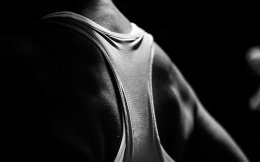
build muscle and lose fat

What Is Muscle + Types of Muscle
Everyone has two different types of muscle: type 1 (slow-twitch) fibers and type 2 (fast-twitch) fibers. "Slow- twitch fibers control endurance. They're what you use for activities like running long distances and low-impact aerobic workouts like Zumba, " says Michele Olson, Ph.D., professor of exercise science at Auburn University Montgomery. Fast-twitch fibers are used for shorter, explosive movements like squat jumps or sprints. They fatigue more quickly and require more recovery time. While type 1 fibers remain about the same size even after you tone, type 2s get larger as they get stronger, so working them is key if you want muscle definition. "If you only focus on training one type, you're missing out on half the perks, " Olson says. (Up next: 7 Common Muscle Myths—Busted.)
What Is Fat + Types of Fat
Fat is a little more complicated. You have white fat, which includes subcutaneous and visceral kinds, and brown fat. Subcutaneous fat is the pinchable stuff around your hips, breasts, butt, belly, and thighs that gives you curves. And yes, it has functional benefits: "Subcutaneous fat is your largest energy reserve, " says Labros Sidossis, Ph.D., a professor of kinesiology and health at Rutgers University. "It also helps regulate body temperature and cushions your internal organs." This type of fat is so essential that your body is wired to hang onto it, which can make it tough to lose.
 Visceral fat hides out under the white fat in your midsection. "Its purpose is to protect organs like your liver and intestines, " Olson says. "But too much visceral fat increases inflammation, raising your risk for heart disease, diabetes, cancer, and high blood pressure, " she adds. Any woman with a waist circumference of more than 35 inches likely has an unhealthy amount of visceral fat. (Here: five really important things to know about body fat.)
Visceral fat hides out under the white fat in your midsection. "Its purpose is to protect organs like your liver and intestines, " Olson says. "But too much visceral fat increases inflammation, raising your risk for heart disease, diabetes, cancer, and high blood pressure, " she adds. Any woman with a waist circumference of more than 35 inches likely has an unhealthy amount of visceral fat. (Here: five really important things to know about body fat.)
Finally, there's brown fat—the kind you actually want more of. "It burns calories instead of storing them, " Sidossis says. Exercise may help the body make more brown fat by producing a hormone called irisin, which activates it, according to research published in the American Journal of Physiology: Endocrinology and Metabolism. And vigorous workouts may even prompt white fat to temporarily turn into a type of brown fat known as beige fat, which also burns calories.
The Muscle-Fat Connection
Like a car engine, your muscles need fuel to move. In fact, the majority of the energy you use during the day is for powering your muscles, which have hundreds of essential purposes besides helping you crush it in the gym, like keeping your heart pumping and maintaining your balance. One of the best sources of that energy is fat. It contains 9 calories per gram, while carbohydrates, another top fuel source, contain just 4 calories.
But your body is fickle. It likes to pick and choose its gas. "You tap fat for energy when you do low-intensity activities like typing on your computer or going for a walk, " says Keith Baar, Ph.D., a professor in the department of physiology and membrane biology at the University of California Davis. "But as you increase physical intensity and your muscles start demanding fuel faster, your body switches to burning carbs, which are quicker to break down into energy."
You've heard of the "fat-burning zone, " an exercise intensity of about 50 to 65 percent of your maximum heart rate, thought to be below the threshold where your body will start burning carbs. It turns out, though, that cranking up the intensity can lead to more fat loss in the end. "You want to burn as many calories overall as possible during your workout so that afterward your body will be forced to use fat to help your muscles recover, " Baar says. "That's how you get the biggest burn."








